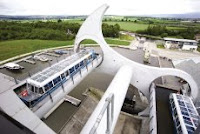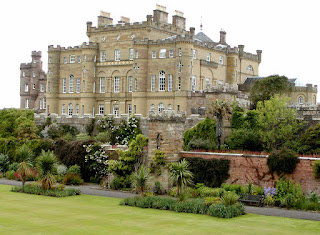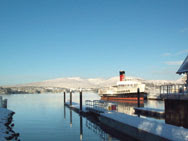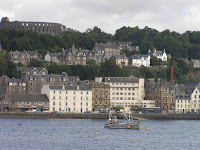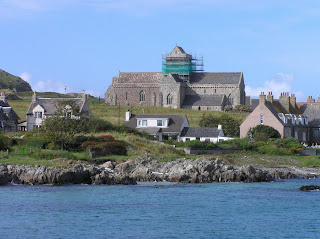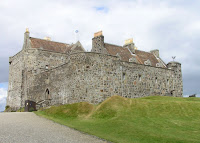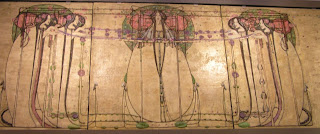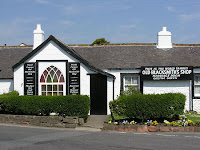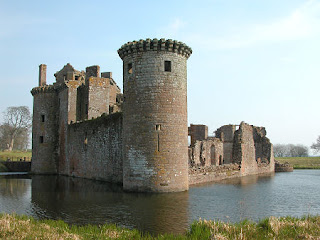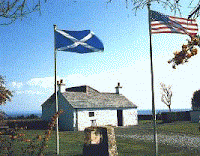 In the interests of research for the Clan Tour, during April with a friend, I visited Linlithgow Palace including the fascinating St Michael's Parish Church and the Falkirk Wheel. Although the wheel has been open for 6 years, this was my first visit. The Falkirk Wheel is unique. Not only is it the first boatlift of its type anywhere, but its combination of engineering ingenuity and architectural imagination creates both an eyecatching working sculpture and Scotland's most unusual tourist attraction. It is a very important
In the interests of research for the Clan Tour, during April with a friend, I visited Linlithgow Palace including the fascinating St Michael's Parish Church and the Falkirk Wheel. Although the wheel has been open for 6 years, this was my first visit. The Falkirk Wheel is unique. Not only is it the first boatlift of its type anywhere, but its combination of engineering ingenuity and architectural imagination creates both an eyecatching working sculpture and Scotland's most unusual tourist attraction. It is a very important  canal structure whose computer controlled machinery gracefully raises or lowers 500 tonnes of boats and water the 25 metre difference between two canals appears complex; but is deceptively simple. As you experience the journey through a canal tunnel and across an aqueduct - before seeming to drop off the end as your boat is lowered by the Wheel - you will be enjoying the most memorable yet gentle of white knuckle rides.
canal structure whose computer controlled machinery gracefully raises or lowers 500 tonnes of boats and water the 25 metre difference between two canals appears complex; but is deceptively simple. As you experience the journey through a canal tunnel and across an aqueduct - before seeming to drop off the end as your boat is lowered by the Wheel - you will be enjoying the most memorable yet gentle of white knuckle rides. The Millenium Link Project has refurbished two major canals; the 61 km long Forth & Clyde and the Union Canal, originally 51km. They are now connected by the Falkirk Wheel where the Union Canal has been lengthened by 2km. The Forth & Clyde is Scotland's oldest canal and runs from Bowling on the Clyde to Grangemouth on the Firth of Forth which was completed in 1790 and created the World's first sea to sea ship canal. The Union Canal known as a contour canal as there are no locks along its main length was completed in 1822. The 2 canals were linked by a flight of 11 locks. The Forth & Clyde canal was closed in 1963 and the Union in 1965. The restoration of the canals has involved the repair or reconstruction work on many of its 500 structures - including bridges, locks and acqueducts. It has been an amazing project. It has become a must see visitor attraction in Scotland ranking just behind Edinburgh Castle!
The Millenium Link Project has refurbished two major canals; the 61 km long Forth & Clyde and the Union Canal, originally 51km. They are now connected by the Falkirk Wheel where the Union Canal has been lengthened by 2km. The Forth & Clyde is Scotland's oldest canal and runs from Bowling on the Clyde to Grangemouth on the Firth of Forth which was completed in 1790 and created the World's first sea to sea ship canal. The Union Canal known as a contour canal as there are no locks along its main length was completed in 1822. The 2 canals were linked by a flight of 11 locks. The Forth & Clyde canal was closed in 1963 and the Union in 1965. The restoration of the canals has involved the repair or reconstruction work on many of its 500 structures - including bridges, locks and acqueducts. It has been an amazing project. It has become a must see visitor attraction in Scotland ranking just behind Edinburgh Castle! But the most striking change was the addition in 1964 of a crown to replace the one removed in 1821. This needed to be light to avoid overloading the tower, and the 58ft high crown you see today is made of aluminium anodised to a gold finish. As you can imagine it is quite a controversial addition as a blend of old and modern.
It would be easy for St Michael's Church to be overwhelmed by its massive and much better known neighbour, Linlithgow Palace. The fact that this has not happened owes much to the quality of work and vision of those responsible for its rebuilding in the 115 years to 1540: and the efforts of those since 1894 to remedy some of what was done to the church from 1559 to 1813.


